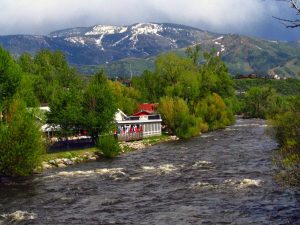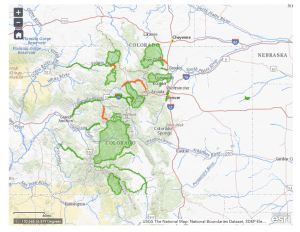Connecting Local Stakeholders for Inclusive Planning on the Yampa River
The Yampa River in northwest Colorado is a rare gem, as it is the only major Colorado River tributary without a large dam, flowing free for almost 300 miles through primarily federal, state, and private ranch lands. The river has high overall health and plays a vital role in sustaining endangered fish species with some of their last-known spawning habitats. “We as a community have been somewhat hands-off with the river,” said Kent Vertrees, President of Friends of the Yampa. “It provides a bunch of ecological services, including downstream at the confluence with the Green River. Plus, we get so much snow in the mountains; the river’s big peak water flows are really what makes it special.”
Recreation, aided by these flows, is abundant in the upper watershed, while permits for the multi-day rafting trip through the lower watershed’s Dinosaur National Monument are awarded to less than 3% of lottery applications – half that of the Grand Canyon! However, this same lack of use and development that keeps the Yampa healthy also makes it a relatively unknown river – without the advocacy and protection of many lesser-quality rivers.
Despite its overall health, the Yampa, like many waters in the West, is facing the possibility of death-by-a-thousand-cuts with increasing human development and a warming, drying climate. In August 2018 demand outpaced supply and the City of Steamboat Springs, Colorado, through which the river flows, prohibited recreation on the river in town, leading to economic consequences for local tube rental companies, fly-fishing outfitters, and other popular tourist activities. “It was the first time ever we had an administrative call on the main stem of the Yampa. Agricultural producers weren’t really surprised, but a lot of people in the community didn’t even understand what that meant,” said Michele Meyer, Executive Director of Community Agriculture Alliance (CAA), a Steamboat-based nonprofit whose mission is to promote and support local agriculture in northwestern Colorado. “We took it as an opportunity to provide education.”

The Yampa River flows through Steamboat Springs, CO, and provides the community with unique opportunities for recreation year-round. Photo courtesy Kent Vertrees, Friends of the Yampa.
Such education came from groups like CAA, Friends of the Yampa and others. Many of these groups form the broad coalition of stakeholders that has worked together since 2016, with River Network support, to develop the Yampa Integrated Water Management Plan (IWMP). The plan, led by the Yampa White Green Basin Roundtable, also involves The Nature Conservancy, Trout Unlimited, NRCS, and area ranchers. “In the Yampa basin, there’s a history of great work and collaboration with recreation, conservation, agriculture, and other partners,” said Vertrees. “[The IWMP] is a logical next step to engage additional stakeholders and examine new projects and ideas.”
Together, this coalition created stakeholder buy-in, identified funding sources, and created the technical scope of work for a plan to identify actions users can take to protect existing and future water uses in the Yampa River basin. Identifying specific actions was a priority for the coalition. According to Meyer, “We heard from the agricultural community that there’s meeting and discussion fatigue; they want to see something happen.”
Work started this summer. River Network’s role (led by Science and Policy Manager Nicole Seltzer, who is based just outside of Steamboat) of bringing together stakeholders and coordinating their efforts has resulted in almost $650,000 in funding to study and plan for the future of the river and the people who rely on it. In recognition of the meeting fatigue described above, initial demonstration projects were built into early phases of the plan to encourage collaboration. “I’m excited to make these things happen and be able to point to them to say, ‘here’s how we provide benefit to agriculture, recreation, and all stakeholders.’” More details on these projects and the full scope of the Yampa IWMP can be found online.

Stream management plans in Colorado, with the Yampa at top left. SMPs were a key watershed health action to come out of Colorado’s Water Plan. In orange are completed plans; in green are those in progress. To explore the full, interactive map, visit Colorado SMP.
The Yampa isn’t alone in planning for progress. River Network is supporting communities across Colorado as they scope and apply for funds. “I don’t think we would be where we’re at without River Network and Nicole Seltzer’s resources. The relationship with the Walton Family Foundation was huge. We wouldn’t have been on their radar without River Network’s involvement.” said Meyer. She also expressed gratitude for the power of the network. “I had no background in water, but CAA was being asked to step up and River Network has educated me and been a resource on the process to make it truly collaborative and inclusive. [Seltzer] goes to other meetings and brings that knowledge back.”
For more information, or to explore the full plan and related studies, visit the Basin Roundtable website. You can find additional information on completed and in-progress stream management plans across Colorado at ColoradoSMP.org, learn more about SMPs with “SMP 101,” and explore the interactive map seen above. River Network and the Colorado Water Conservation Board are developing further content for ColoradoSMP.org, with more information to come soon.






[…] leading the Yampa White Green Basin Roundtable’s Integrated Water Management Plan (IWMP). River Network’s leadership of the IWMP, and the resulting regular conversations and shared goals and objectives has improved the basin’s […]